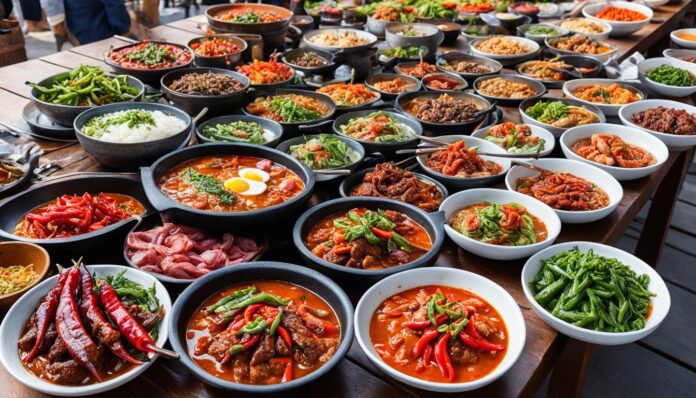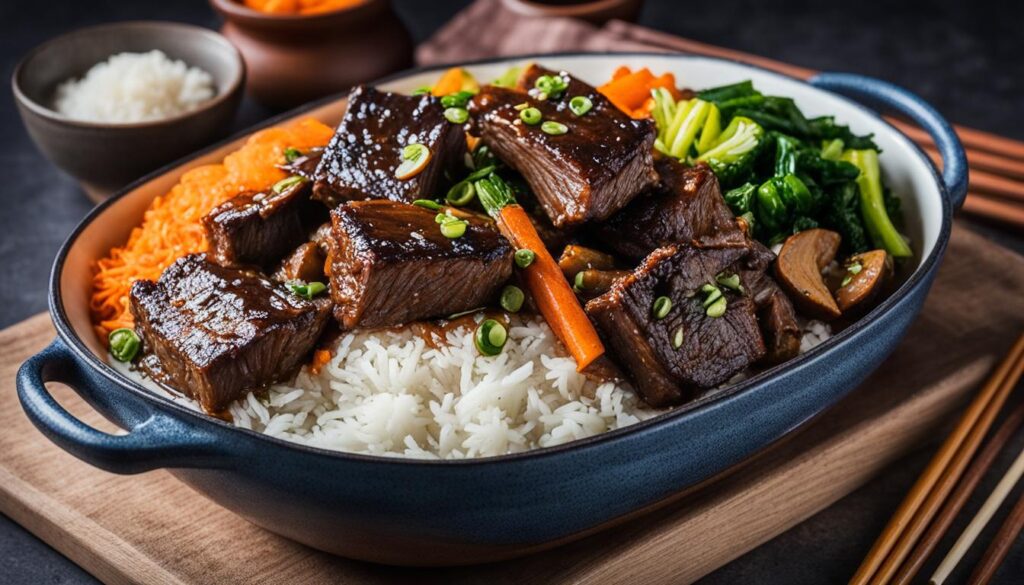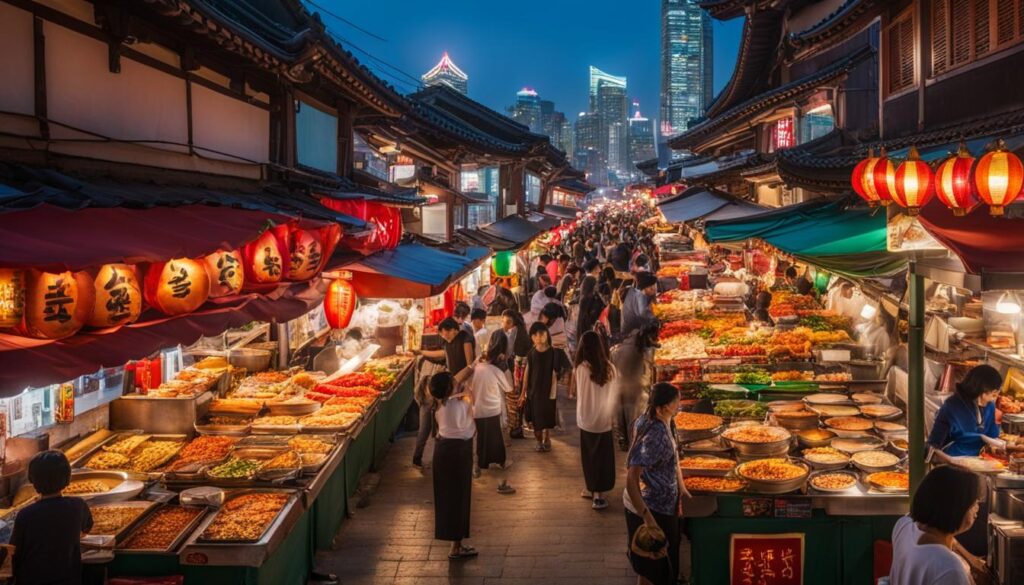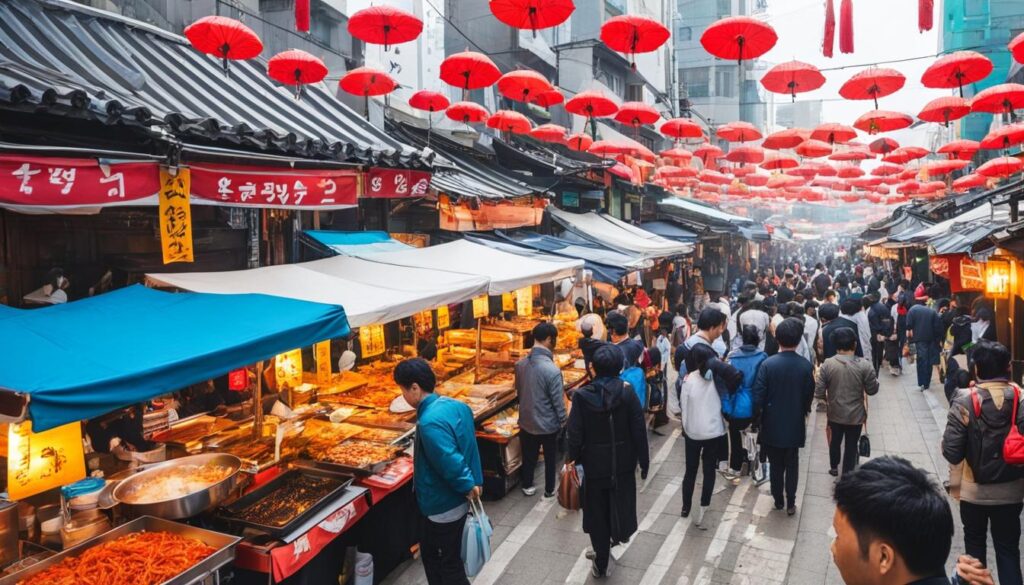If you’re a fan of Korean food, chances are you’ve tried the quintessential dishes of kimchi and bibimbap. But have you discovered the best authentic Korean food experiences beyond these popular choices?
It’s time to dive deeper into Korean cuisine and explore the wide variety of flavors and dishes that extend beyond kimchi and bibimbap. From savory stews to unique street foods, Korean food offers a world of culinary delights.
In this article, we’ll guide you through the best Korean food experiences beyond kimchi and bibimbap. Whether you’re a seasoned Korean food enthusiast or new to the cuisine, get ready to uncover hidden gems and savor unique flavors.
Must-Try Korean Dishes Beyond Kimchi and Bibimbap
If you think Korean cuisine is only about kimchi and bibimbap, think again! Korean culinary tradition has much more to offer. Prepare to indulge in a plethora of dishes that will take your taste buds on a unique journey of authentic Korean flavors. Here are some must-try Korean dishes beyond the well-known kimchi and bibimbap:
Sundubu-jjigae
Sundubu-jjigae is a popular Korean stew made with soft tofu, seafood, vegetables, mushrooms, and chili pepper flakes. It is served with a raw egg that you crack into the bubbling stew, which then cooks further in the stew. This hearty, spicy stew is perfect for those chilly days, and its rich and flavorful broth will warm you up from the inside out.
Jeon
Jeon are savory pancakes made with various ingredients, such as seafood, kimchi, meat, or vegetables, and then dipped in a soy sauce-based dip. They are a popular Korean snack and are often consumed as an appetizer or side dish. The crispy outside paired with the soft and flavorful inside of the pancakes make for an exquisite culinary experience.
Jjajangmyeon
Jjajangmyeon is a Korean-Chinese noodle dish that originated in China’s Shandong region. It is made with thick wheat noodles and black bean paste, mixed with vegetables and meat. The dish has a slightly sweet and savory taste and is often garnished with cucumbers and scallions.
Did you know? Jjajangmyeon is one of the most popular delivery foods in Korea, often ordered from Chinese restaurants.
Haejang-guk
Haejang-guk, also known as “hangover soup,” is a nourishing soup made with diced meat, vegetables, bean sprouts, and congealed ox blood. It is the ultimate comfort food and is believed to have restorative effects after a wild night out.
Hobak-juk
Hobak-juk is a sweet Korean porridge made from ground squash, glutinous rice powder, and sugar. It is usually served as a dessert or snack and is known for its creamy and smooth texture, with a subtle sweetness that is not overpowering.
These are just a few examples of the amazing dishes waiting for you beyond the popularity of kimchi and bibimbap. Venture out, try something new, and experience the full range of Korean cuisine.
Exploring Korean Cuisine Beyond Kimchi and Bibimbap
When it comes to Korean cuisine, kimchi and bibimbap may be the first dishes that come to mind, but there is a world of flavors and traditions waiting to be explored beyond these popular dishes.
By delving deeper into Korean cuisine, you can learn about the various ingredients, cooking techniques, and regional specialties that make Korean food so unique. From sweet and savory flavors to spicy and fermented tastes, Korean cuisine offers an incredible range of flavors and textures.
One way to experience the authentic flavors of Korean cuisine is by visiting traditional restaurants and markets. Here, you can sample a variety of dishes and ingredients while immersing yourself in the vibrant atmosphere of Korean dining culture.
Another way to explore Korean cuisine is by trying lesser-known dishes and specialties. For example, have you ever tried jajangmyeon, a savory noodle dish made with black bean sauce? Or how about haemul pajeon, a delicious seafood pancake? These and other lesser-known dishes are definitely worth trying.
Ingredient Spotlight: Gochujang
One ingredient that plays a central role in Korean cuisine is gochujang, a fermented chili paste made from red chili, glutinous rice, fermented soybeans, and salt. Gochujang is a key ingredient in many Korean dishes, adding depth of flavor and a spicy kick.
Considered a staple of Korean cuisine, gochujang is used in a variety of dishes, from stews and soups to marinades and dipping sauces. It can also be used as a spread on sandwiches or mixed into dressings for salads.
“Gochujang is the foundation of Korean cuisine. It adds a deep, rich flavor and complexity to dishes that can’t be replicated with any other ingredient.” – Chef Roy Choi
Next time you’re exploring Korean cuisine beyond kimchi and bibimbap, be sure to try a dish featuring gochujang.
Hidden Gems of Korean Food Beyond Kimchi and Bibimbap
If you’re ready to expand your culinary horizons and try lesser-known dishes from Korean cuisine, you’re in for a treat. There are plenty of hidden gems to discover that are equally delicious and worth trying, despite not being as famous as the classic dishes.
One of the best ways to discover these hidden gems is by exploring street foods. Tteokbokki is a popular snack made of chewy rice cakes, fish cakes, and a spicy sauce made of gochujang. Another great option is Kimbap, a dish that’s similar to sushi, but with its own unique flavors and ingredients.
If you’re feeling more adventurous, consider trying some unique regional delicacies. In Jeju Island, you can find heukdwaeji, or black pork, which is a local specialty known for its rich flavor. In the Gyeongsang province, San-nakji is a popular dish made of live octopus that’s cut into small pieces and sprinkled with sesame oil and sesame seeds.
Don’t be afraid to step outside of your comfort zone and try something new. You never know what hidden gem you might discover and fall in love with.
Savoring Unique Korean Food Beyond Kimchi and Bibimbap
Get ready to expand your taste palate with the distinct and unique flavors of Korean cuisine that go beyond the familiar tastes of kimchi and bibimbap. From savory dishes to sweet treats, Korean cuisine offers a diverse range of flavors and ingredients that will excite your taste buds. Here are some must-try dishes:
| Dish | Description |
|---|---|
| Fermented Soybean Paste Stew (Doenjang Jjigae) | This hearty stew showcases Korea’s love of fermented foods. Made with protein-rich ingredients like tofu, meat, and veggies, this dish has a rich, savory flavor that will warm you up on a chilly day. |
| Grilled Marinated Meat (Bulgogi) | This popular Korean dish features thin-sliced beef that has been marinated in a sweet and savory sauce. Grilled to perfection, bulgogi is delicious on its own or wrapped in lettuce leaves for a fresh and light option. |
| Stir-Fried Glass Noodles (Japchae) | These glass noodles are made from sweet potato starch and are stir-fried with veggies, meat, and a sweet and savory sauce. Japchae is a perfect side dish or light meal option. |
And for dessert, don’t forget to try Patbingsu, a popular shaved ice dessert topped with sweet red beans, fruit, and condensed milk.
“Korean cuisine offers a vibrant mix of flavors and ingredients beyond the popular dishes of kimchi and bibimbap.”
Experience Korean Culture Through Its Food
Food and culture are deeply intertwined in Korea, and trying new dishes is a great way to experience the country’s rich heritage. Korean cuisine is known for its emphasis on balance and harmony, with dishes featuring a variety of flavors and textures. So why not step out of your comfort zone and try something new?
Top Korean Dining Experiences Beyond Kimchi and Bibimbap
If you’re looking for top-notch Korean dining experiences that go beyond the usual choices of kimchi and bibimbap, you’re in luck. Korea is a country that takes its food seriously and offers a wide range of dining options to explore. From traditional barbecue restaurants to cozy neighborhood eateries and upscale fine dining establishments, there’s something for everyone.
For a unique and unforgettable experience, head to Jungsik in New York City, known for its contemporary take on Korean cuisine. The restaurant offers a tasting menu featuring dishes like truffle-infused fried chicken and foie gras with smoked eel. If you’re in LA, check out Gwang Yang BBQ, which serves up high-quality cuts of meat cooked to perfection on charcoal grills right at your table.
For a more casual and authentic experience, try Myeongdong Kyoja in Seoul, known for its handmade noodles in savory broth. Or visit Osegyehyang in Busan for a taste of seafood like you’ve never had before.
No matter where you go, you’re sure to find a top Korean dining experience that will satisfy your taste buds and leave you wanting more.
Experiencing Authentic Korean Food Beyond Kimchi and Bibimbap
Are you ready to dive even deeper into authentic Korean cuisine? Beyond the popular dishes of kimchi and bibimbap, there is a vast array of unique flavors and tastes waiting to be explored.
First, consider learning about traditional cooking methods that make Korean food so special. One popular example is “jjigae,” a type of hearty Korean stew that is typically served with rice. Jjigae is made by boiling various ingredients in a cast-iron pot, resulting in a rich and flavorful dish that is perfect for colder weather.
In addition, exploring regional specialties is a must. Each region of Korea has its own unique cuisine, and trying these dishes is a perfect way to get a sense of the country’s culinary diversity. For example, “Jeonju bibimbap” is a popular dish in the eponymous southern city. It is served with gochujang, sesame oil, and vegetables, resulting in a fresh and savory taste.
Finally, consider the cultural significance of Korean cuisine. Food and family are closely intertwined in Korean culture, so sharing a meal with loved ones is an important part of daily life. Savoring authentic Korean food is more than just trying new dishes; it’s about immersing yourself in a rich and vibrant culture.
“Savoring authentic Korean food is more than just trying new dishes; it’s about immersing yourself in a rich and vibrant culture.”
Ready to take the plunge? Head to your local Korean restaurant and order something new and exciting today.
Exploring Korean Cuisine Beyond the Basics
Ready to expand your knowledge of Korean cuisine beyond the popular dishes of kimchi and bibimbap? Delve into lesser-known dishes and unique ingredients that showcase the cultural and historical influences on Korean food.
One dish to try is Japchae, a stir-fried glass noodle dish that combines meat, vegetables, and a sweet soy sauce. Another underrated dish is Ssamjang, a savory fermented soybean paste used as a condiment for lettuce wraps.
Additionally, exploring regional specialties will allow you to discover the diverse flavors of Korean cuisine. For example, the cuisine of Jeju Island is known for its fresh seafood and black pork dishes, while the northeast region specializes in naengmyeon, a cold noodle soup.
Expand your culinary horizons and experiment with new and exciting flavors in Korean cuisine beyond kimchi and bibimbap.
“Korean cuisine is deeply connected to the country’s long history and reflects its unique culture and geography. From street foods to fine dining, there is something for everyone to explore.”
Conclusion
In conclusion, if you’re a foodie looking to expand your culinary horizons, Korean cuisine beyond kimchi and bibimbap offers a vast array of flavors, dishes, and dining experiences to explore. You can savor the unique tastes of lesser-known dishes, uncover hidden gems of regional delicacies, and immerse yourself in the vibrant Korean dining culture.
By exploring beyond the basics of Korean food, you can expand your knowledge of traditional cooking methods, authentic ingredients, and cultural influences that have shaped the cuisine. Whether you’re looking to indulge in the distinct and spicy flavors of Korean barbecue or try the sour and savory flavors of fermented stews, there’s something for everyone’s taste buds.
So, next time you’re craving Korean food, don’t limit yourself to kimchi and bibimbap. Instead, step out of your comfort zone and explore the diverse and authentic tastes of Korean cuisine beyond the basics.

















































